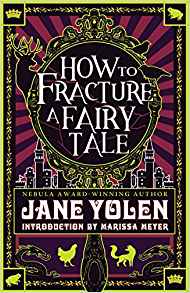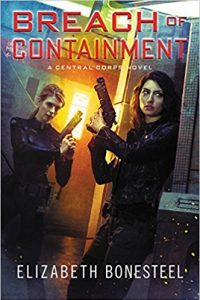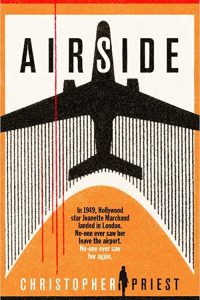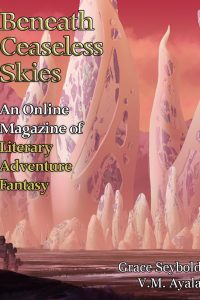Gary K. Wolfe Reviews How to Fracture a Fairy Tale by Jane Yolen
 How to Fracture a Fairy Tale, Jane Yolen (Tachyon 978-1-61696-306-4, $16.95, 320pp, tp) November 2018.
How to Fracture a Fairy Tale, Jane Yolen (Tachyon 978-1-61696-306-4, $16.95, 320pp, tp) November 2018.
Chances are that not every reader of Jane Yolen’s collection How to Fracture a Fairy Tale – which follows close upon her World Fantasy Award winning The Emerald Circus – will remember the classic Rocky and Bullwinkle segments from nearly 60 years ago, narrated by Edward Everett Horton, which as far as I know first popularized the term “fractured fairy tales,” though of course parodies or burlesques of one sort or another have been around for pretty much as long as there have been fairy tales in the first place. As Yolen points out in her introduction to this generous collection – 28 stories, 29 poems, and commentaries – “fracture” can have a lot of meanings: subverting the story’s basic assumptions, re-examining it from a different point of view, revealing possible unexamined meanings, shifting the time or setting, or simply turning some of the more annoying clichés of the genre on their heads. It can also mean breaking a bone to set it right, and she does of bit of that here as well. Yolen is a scholar as well as a prolific writer and interpreter of tales, and she knows that one of the secrets of enduring stories is their malleability; stories may be about sacred things, but there’s nothing particularly sacred about the stories themselves.
One of Yolen’s most famous joke stories is “Sleeping Ugly”, published originally as an illustrated book in 1981 and (I think) collected here for the first time since, though Yolen tells us it’s become a favorite among oral storytellers. It’s about a gorgeous but thoroughly rotten princess who so annoys a fairy – as well as the prince and the plain girl he falls in love with – that after she’s been put to sleep for a hundred years, no one bothers to wake her up. A similarly selfish princess is featured in “The Golden Balls”, a variation on the Frog Prince. “Happy Dens, or a Day in the Old Wolves’ Home” is a good example of shifting perspective, as Nurse Lamb, on her first day in the wolf retirement home, hears the real stories of Red Riding Hood, the Three Little Pigs, and Peter and the Wolf as seen from the wolves’ point of view. Similarly, in what is the most imaginative perspective shift, “The Bridge’s Complaint” is exactly that – the tale of trolls and billy-goats seen from the jaded perspective of a bridge who remembers better days. The body-image assumptions that have troubled some readers about the traditional Cinderella tale are addressed directly in “Cinder Elephant”, a derogatory name given to the “lovely big girl” by her wicked stepmother and stepsisters, until she of course wins the prince at the ball, based largely on their common love of baseball, football, etc. (one of the “morals” Yolen appends is “Not everyone who loves balls has them.”) “The Moon Ribbon” begins like a Cinderella variation, but segues into a bit of George MacDonald before becoming a tale fully Yolen’s own. “Green Plague” reimagines the Pied Piper story as a plague of frogs, which leads eventually to all the teenage children in the village leaving for a rock concert and never returning, which sounds way more credible than the original.
There are, of course, disturbing undersides to many of these tales, and Yolen doesn’t avoid them. The darkest variation on the Cinderella story is “Allerleirauh”, which is creepy enough in the Grimm version, but Yolen strips away the decoration to bring the predatory incest theme fully to the front. In “Granny Rumple”, Rumpelstiltskin is reinterpreted as an anti-Semitic fable, complete with blood libel. Set in the Ukraine, it links the liminal space of fairy tales to a concrete time and place, and even to Yolen’s own family. An even darker chapter of Jewish history, the Holocaust, features in “Slipping Sideways Through Eternity”, in which a young girl, a promising artist, opens the door for Elijah during a seder and actually sees him; he later meets her again and transports her back in time to a concentration camp in 1943, where she learns she must forge her own future. In the short but heartbreaking “Sister Death”, Lilith travels the world for five thousand years before meeting a child, condemned to a gas chamber, who greets her as his mother.
Yolen draws on an impressive variety of other folk and fairy tale traditions – Chinese dragon stories (“One Ox, Two Ox, Three Ox, and the Dragon King”), Greek mythology (“Sun/Flight”, a variation on Icarus), Japanese kitsune stories (“The Fox Wife”), Scottish legends (“The Faery Flag”, “Sule Skerry”), Arthuriana (“The Gwynfahr”), Native American tales (“The Woman Who Loved a Bear”), even vampire lore (the surprisingly tender tale of a revenant mom, “Mama Gone”). The poems which accompany the story comments at the end of the book also offer additional perspectives – sometimes a bit sharper and more directly political – on the themes of the stories. If The Emerald Circus provided an extensive overview of Yolen’s dialogue with many of her literary predecessors from Andersen to Baum, How to Fracture a Fairy Tale serves as a useful and timely companion volume, demonstrating an equally astute and critical dialogue with the world’s folk traditions. While nine of these stories were included in the NESFA retrospective Once Upon a Time (She Said) in 2005, and a half dozen were in Sister Emily’s Lightship and Other Stories way back in 2000, these Tachyon volumes are an invaluable reminder of Yolen’s central role in contemporary fantasy, and perhaps an equally invaluable starting point for readers daunted by the sheer volume and variety of her work.
Gary K. Wolfe is Emeritus Professor of Humanities at Roosevelt University and a reviewer for Locus magazine since 1991. His reviews have been collected in Soundings (BSFA Award 2006; Hugo nominee), Bearings (Hugo nominee 2011), and Sightings (2011), and his Evaporating Genres: Essays on Fantastic Literature (Wesleyan) received the Locus Award in 2012. Earlier books include The Known and the Unknown: The Iconography of Science Fiction (Eaton Award, 1981), Harlan Ellison: The Edge of Forever (with Ellen Weil, 2002), and David Lindsay (1982). For the Library of America, he edited American Science Fiction: Nine Classic Novels of the 1950s in 2012, with a similar set for the 1960s forthcoming. He has received the Pilgrim Award from the Science Fiction Research Association, the Distinguished Scholarship Award from the International Association for the Fantastic in the Arts, and a Special World Fantasy Award for criticism. His 24-lecture series How Great Science Fiction Works appeared from The Great Courses in 2016. He has received six Hugo nominations, two for his reviews collections and four for The Coode Street Podcast, which he has co-hosted with Jonathan Strahan for more than 300 episodes. He lives in Chicago.
This review and more like it in the January 2019 issue of Locus.
 While you are here, please take a moment to support Locus with a one-time or recurring donation. We rely on reader donations to keep the magazine and site going, and would like to keep the site paywall free, but WE NEED YOUR FINANCIAL SUPPORT to continue quality coverage of the science fiction and fantasy field.
While you are here, please take a moment to support Locus with a one-time or recurring donation. We rely on reader donations to keep the magazine and site going, and would like to keep the site paywall free, but WE NEED YOUR FINANCIAL SUPPORT to continue quality coverage of the science fiction and fantasy field.








